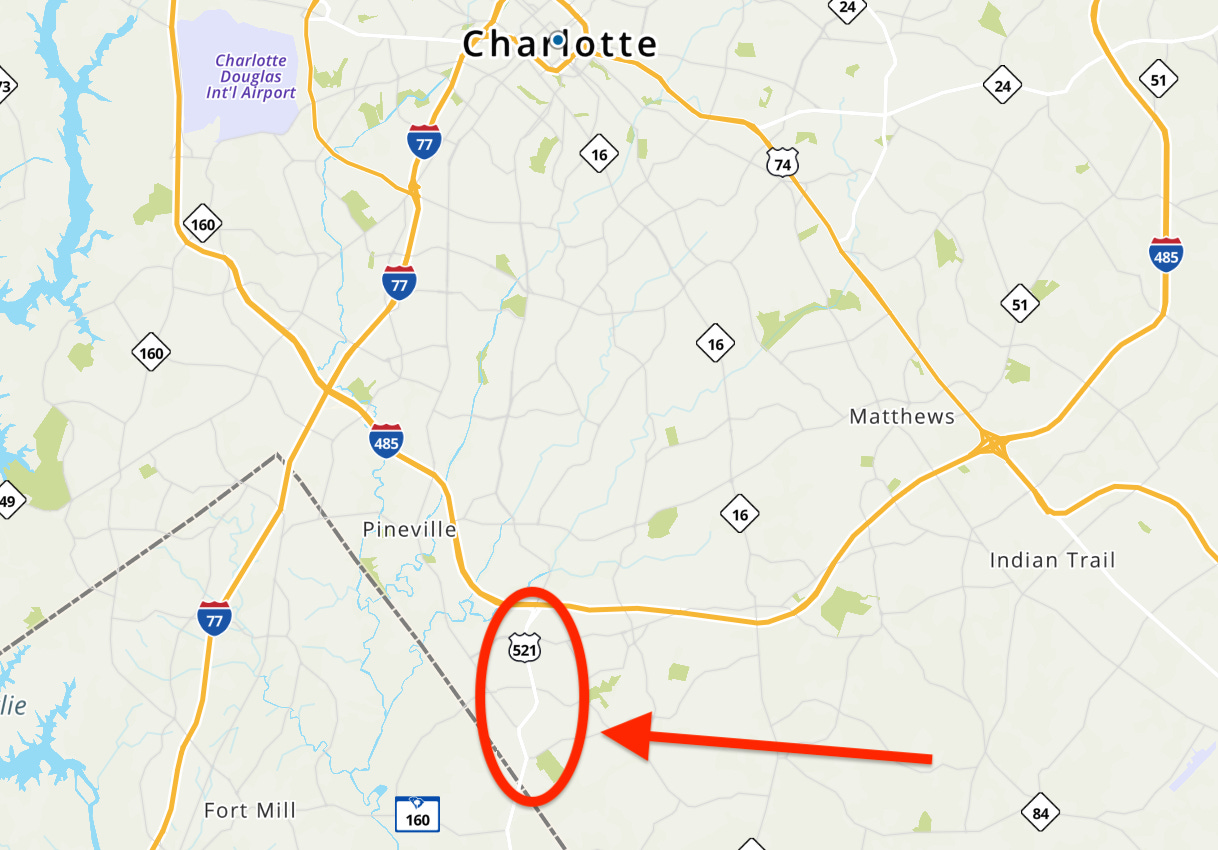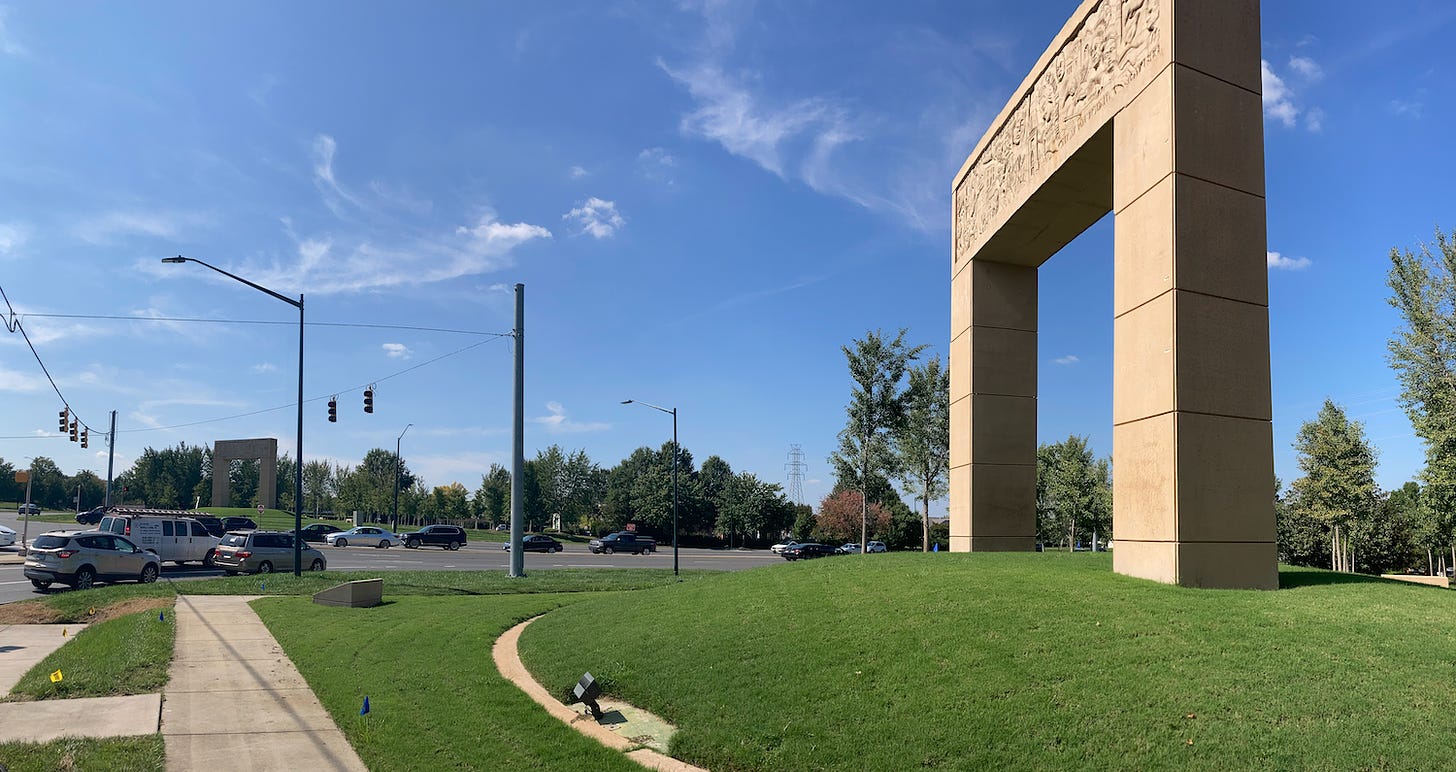A road conundrum in Ballantyne
Traffic on U.S. 521 is getting worse. Transportation planners are still working on a solution.
You’re reading Transit Time, a weekly newsletter for Charlotte people who leave the house. Cars, buses, light rail, bikes, scooters … if you use it to get around the city, we write about it. Transit Time is produced in partnership between The Charlotte Ledger and WFAE.
Widening U.S. 521 (Johnston Road) is becoming more complex, as traffic surges and concerns mount; NCDOT explores new intersections, raised roads … and a tunnel?
U.S. 521 in south Charlotte, also known as Johnston Road, carries about 60,000 vehicles a day near I-485. The amount of traffic is expected to surge in the coming years.
by Tony Mecia
Plans to widen U.S. 521 in Charlotte’s Ballantyne area have been on the books for many years.
But now, as the area grows — with rapidly developing Indian Land, S.C., to the south and the huge Ballantyne Reimagined project starting to come online to the north — the state’s transportation department is finding it trickier, and more costly, to find ways to move the increasing load of traffic.
And it might be at least several more years until officials settle on a new plan and even start to get it built.
What was envisioned years ago as a routine road widening is now becoming more complex: State transportation officials have been examining new types of intersections to speed traffic — but those plans have drawn objections from residents of the Ballantyne Country Club neighborhood and elsewhere.
And now, with the addition of hundreds of new apartments and dozens of shops and restaurants near I-485, officials are looking at the possibility of broader and more expensive measures, such as a flyover intersection or even, gasp, a tunnel. They say they want to ensure the area has the infrastructure it needs for the future and not devise a solution that will be instantly outdated.
“With all the development that is going on in South Carolina, with all the development that is and has recently occurred right in the heart of Ballantyne itself, the traffic volumes out there are tremendous,” says engineer Brett Canipe with the N.C. Department of Transportation (NCDOT).
At stake is the future of a three-mile stretch of road between I-485 and the South Carolina line — a corridor Canipe says is projected to have the second-most traffic of any state-maintained (non-interstate) road in the Charlotte region, behind only Independence Boulevard.
The section of U.S. 521 north of Ballantyne Commons Parkway carries about 60,000 vehicles a day, according to the most recent traffic counts. The number is projected to go to around 100,000 in the coming years, state transportation officials say.
The state’s road-planning document, known as the State Transportation Improvement Plan, or STIP, describes the project as “widen to multi-lanes” between Ballantyne Commons Parkway and the state line, at a cost of $54 million. Initial plans called for the corridor to go from four lanes to six.
But state officials, noting that the traffic is expected to be heavier than anticipated, have been looking at more comprehensive solutions — including alternatives opposed by residents living in neighborhoods in the area.
A year ago, The Charlotte Ledger reported that officials were examining “reduced conflict intersections” that would help speed traffic by allowing only right turns onto Johnston Road from the streets that intersect it. That would mean that to turn left from adjacent neighborhoods, drivers would have to turn right and then make a U-turn.
Draft maps of plans to expand Johnston Road south of I-485 to the South Carolina border show several “reduced conflict intersections.” The plans are in the early stages and are still subject to change, according to the N.C. Department of Transportation. (NCDOT)
Some residents also expressed alarm that widening U.S. 521 at Ballantyne Commons Parkway could require the removal of Ballantyne’s iconic monuments. The monuments, erected when Ballantyne was built in the late 1990s, symbolize different themes of the Charlotte region’s history: technology, transportation, finance and the human spirit.
Four monuments at the intersection of Ballantyne Commons Parkway at U.S. 521 (Johnston Road) could be in the way of a future road widening. They were designed and built in the late 1990s by Yugoslavian artist Boris Tomic over three years.
Now, Canipe says, the state is also examining alternatives north of Ballantyne Commons Parkway to handle the anticipated surge in traffic. One idea that seems to be gaining traction is a “grade separation” at Ballantyne Commons Parkway or Brixham Hill Avenue — an elevated section of road often known as a “flyover” intersection. The design is still unclear, but the idea generally involves building an overpass that allows through traffic to avoid congested intersections.
While that can be pricey, Canipe says, so is south Charlotte real estate that the state would need to acquire to widen Johnston Road: “Going vertical may not necessarily be more expensive.”
Asked about the possibility of a tunnel, Canipe acknowledged that planners have “used the T-word before” (“tunnel”) in exploring possibilities. He says officials looked into “one tunnel concept that was taken to a little bit more detailed analytical level” at Brixham Hill but concluded it is probably not feasible.
He stresses that no decisions have been made about any designs.
Last year, the state shifted the date for construction to start from 2026 to 2028. Canipe says it will be tough to meet that 2028 start date. The state won’t start acquiring land until it settles on a design, and it is working in coordination with the city of Charlotte and talking with neighbors.
City transit plans call for the Blue Line light rail to be extended into Pineville and Ballantyne to the Ballantyne Reimagined development. But with no funding for the city’s transit plan, that extension is at least 20 years away.
Marc Bickler, president of the Ballantyne Country Club homeowners association, said his neighborhood has been working with NCDOT and would like a solution that doesn’t further divide the neighborhood by making the road even more gargantuan. The neighborhood, and its golf course, are split down the middle by U.S. 521.
“What we want is planning that understands we’re a community, not a corridor, and has a vision for the future that sees Ballantyne as an integral part of Charlotte, not a remote highway interchange with a traffic problem,” Bickler said in a text message to Transit Time.
Neighborhood leaders wrote to residents in an email this week that the Johnston Road project is “back in the design phase” and that it doesn’t appear there will be any road widening “in the near future.”
Ed Driggs, the Charlotte City Council member who represents the area and heads the council committee on transportation, said something needs to be done to address the growing amount of traffic, but that the right solution hasn’t emerged yet.
“We appreciate the investment and the prospect of relief on 521, but we do need to work some more to address the concerns of Ballantyne Country Club,” he said.
Canipe said there are a lot of ongoing discussions and a lot of moving pieces as NCDOT works to figure out a solution: “We are trying to develop some concepts that might help us solve this problem. That does take time.”
Tony Mecia is executive editor of The Charlotte Ledger. Reach him at tony@cltledger.com.
Related articles:
“Plans for Johnston Road widening could ban left turns from many cross streets” (Jan. 14, 2023)
“Iconic Ballantyne monuments endangered by planned road widening” (Sept. 21, 2022)
—
What do you think NCDOT should do?
Take our wildly unscientific reader poll that oversimplifies answers and allows for only one response:
Ledger members are also invited to leave a comment:
Transit Time is a production of The Charlotte Ledger and WFAE. You can adjust your newsletter preferences on the ‘My Account’ page.
Did somebody forward you this newsletter and you need to sign up? You can do that here:
Other affiliated Charlotte newsletters and podcasts that might interest you:
The Charlotte Ledger Business Newsletter, Ways of Life newsletter (obituaries) and Fútbol Friday (Charlotte FC), available from The Charlotte Ledger.
The Inside Politics newsletter, available from WFAE.










There is another option. South Carolina could look at another route to 77 from Indian Land that does not require coming through the center of Ballantyne. So much is being done to build up the community of Ballantyne in terms of retail, entertainment etc. it doesn’t need another Independence Boulevard running through it.
Another option may be to widen Lancaster Highway to 2 lanes and divert traffic coming from the south to take Lancaster Highway to 485 in Pineville instead of through the middle of Ballantyne.
Maybe Charlotte / Mecklenburg should consider limiting building permits like some other towns I.e. Mt Pleasant SC until infrastructure catches up or we will all be in gridlock and Charlotte will no longer be so desirable.